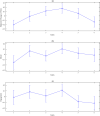The psychophysiological mechanisms of real-world time experience
- PMID: 35902608
- PMCID: PMC9330997
- DOI: 10.1038/s41598-022-16198-z
The psychophysiological mechanisms of real-world time experience
Abstract
Our sense of time is fallible, often resulting in the sensation of time flying by quickly or dragging slowly. It has been suggested that changes in sympathetic (SNS) and parasympathetic nervous system (PNS) activity may influence the perceived passage of time, however this proposition has never been tested during real-world temporal experience. The current study directly tested the relationship between the passage of time and SNS-PNS activity in the real-world. Sixty-seven participants completed a normal day's activities whilst wearing sensors to capture electrocardiography (ECG), electrodermal activity (EDA) and movement. They also provided hourly rating of the subjective speed at which time was passing. Results revealed that greater SNS activity (e.g., increased heart rate, frequency of phasic skin conductance response) was associated with time passing more quickly. PNS activity was not related to time experience. Whilst the findings support previous suggestions that changes in physiological arousal are associated with distortions to the passage of time, the effects are small and other factors are likely to contribute to real-world temporal experience.
© 2022. The Author(s).
Conflict of interest statement
The authors declare no competing interests.
Figures



References
-
- Wearden J, O’Donoghue A, Ogden R, Montgomery C. Subjective duration in the laboratory and the world outside. In: Arstila V, Lloyd D, editors. Subjective Time: The Philosophy, Psychology, and Neuroscience of Temporality. MIT Press; 2014. p. 287.
Publication types
MeSH terms
LinkOut - more resources
Full Text Sources

